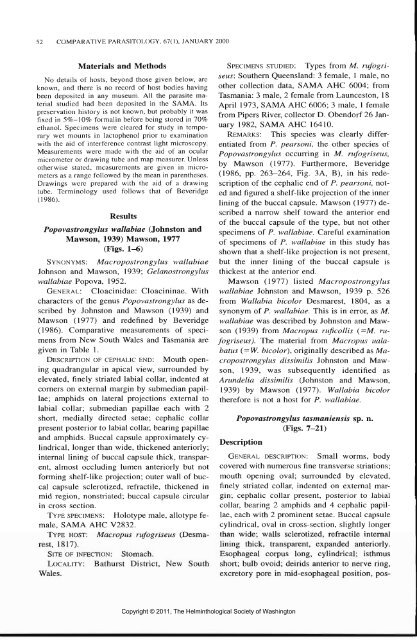Comparative Parasitology 67(1) 2000 - Peru State College
Comparative Parasitology 67(1) 2000 - Peru State College
Comparative Parasitology 67(1) 2000 - Peru State College
Create successful ePaper yourself
Turn your PDF publications into a flip-book with our unique Google optimized e-Paper software.
52 COMPARATIVE PARASITOLOGY, <strong>67</strong>(1), JANUARY <strong>2000</strong><br />
Materials and Methods<br />
No details of hosts, beyond those given below, are<br />
known, and there is no record of host bodies having<br />
been deposited in any museum. All the parasite material<br />
studied had been deposited in the SAMA. Its<br />
preservation history is not known, but probably it was<br />
fixed in 5%—10% formalin before being stored in 70%<br />
ethanol. Specimens were cleared for study in temporary<br />
wet mounts in lactophcnol prior to examination<br />
with the aid of interference contrast light microscopy.<br />
Measurements were made with the aid of an ocular<br />
micrometer or drawing tube and map measurer. Unless<br />
otherwise stated, measurements are given in micrometers<br />
as a range followed by the mean in parentheses.<br />
Drawings were prepared with the aid of a drawing<br />
tube. Terminology used follows that of Beveridge<br />
(1986).<br />
Results<br />
Popovastrongylus wallabiae (Johnston and<br />
Mawson, 1939) Mawson, 1977<br />
(Figs. 1-6)<br />
SYNONYMS: Macropostrongylus wallabiae<br />
Johnson and Mawson, 1939; Gelanostrongylus<br />
wallabiae Popova, 1952.<br />
GENERAL: Cloacinidae: Cloacininae. With<br />
characters of the genus Popovastrongylus as described<br />
by Johnston and Mawson (1939) and<br />
Mawson (1977) and redefined by Beveridge<br />
(1986). <strong>Comparative</strong> measurements of specimens<br />
from New South Wales and Tasmania are<br />
given in Table 1.<br />
DESCRIPTION OF CEPHALIC END: Mouth opening<br />
quadrangular in apical view, surrounded by<br />
elevated, finely striated labial collar, indented at<br />
corners on external margin by submedian papillae;<br />
amphids on lateral projections external to<br />
labial collar; submedian papillae each with 2<br />
short, medially directed setae; cephalic collar<br />
present posterior to labial collar, bearing papillae<br />
and amphids. Buccal capsule approximately cylindrical,<br />
longer than wide, thickened anteriorly;<br />
internal lining of buccal capsule thick, transparent,<br />
almost occluding lumen anteriorly but not<br />
forming shelf-like projection; outer wall of buccal<br />
capsule sclerotized, refractile, thickened in<br />
mid region, nonstriated; buccal capsule circular<br />
in cross section.<br />
TYPE SPECIMENS: Holotype male, allotype female,<br />
SAMA AHC V2832.<br />
TYPE HOST: Macropus rufogriseus (Desmarest,<br />
1817).<br />
SITE OF INFECTION: Stomach.<br />
LOCALITY: Bathurst District, New South<br />
Wales.<br />
SPECIMENS STUDIED: Types from M. rufogriseus:<br />
Southern Queensland: 3 female, 1 male, no<br />
other collection data, SAMA AHC 6004; from<br />
Tasmania: 3 male, 2 female from Launceston, 18<br />
April 1973, SAMA AHC 6006; 3 male, 1 female<br />
from Pipers River, collector D. Obendorf 26 January<br />
1982, SAMA AHC 16410.<br />
REMARKS: This species was clearly differentiated<br />
from P. pearsoni, the other species of<br />
Popovastrongylus occurring in M. rufogriseus,<br />
by Mawson (1977). Furthermore, Beveridge<br />
(1986, pp. 263-264, Fig. 3A, B), in his redescription<br />
of the cephalic end of P. pearsoni, noted<br />
and figured a shelf-like projection of the inner<br />
lining of the buccal capsule. Mawson (1977) described<br />
a narrow shelf toward the anterior end<br />
of the buccal capsule of the type, but not other<br />
specimens of P. wallabiae. Careful examination<br />
of specimens of P. wallabiae in this study has<br />
shown that a shelf-like projection is not present,<br />
but the inner lining of the buccal capsule is<br />
thickest at the anterior end.<br />
Mawson (1977) listed Macropostrongylus<br />
wallabiae Johnston and Mawson, 1939 p. 526<br />
from Wallabia bicolor Desmarest, 1804, as a<br />
synonym of P. wallabiae. This is in error, as M.<br />
wallabiae was described by Johnston and Mawson<br />
(1939) from Macropus ruficollis (=M. rufogriseus).<br />
The material from Macropus ualabatus<br />
( = W. bicolor), originally described as Macropostrongylus<br />
dissimilis Johnston and Mawson,<br />
1939, was subsequently identified as<br />
Arundelia dissimilis (Johnston and Mawson,<br />
1939) by Mawson (1977). Wallabia bicolor<br />
therefore is not a host for P. wallabiae.<br />
Popovastrongylus tasmaniensis sp. n.<br />
(Figs. 7-21)<br />
Description<br />
Copyright © 2011, The Helminthological Society of Washington<br />
GENERAL DESCRIPTION: Small worms, body<br />
covered with numerous fine transverse striations;<br />
mouth opening oval; surrounded by elevated,<br />
finely striated collar, indented on external margin;<br />
cephalic collar present, posterior to labial<br />
collar, bearing 2 amphids and 4 cephalic papillae,<br />
each with 2 prominent setae. Buccal capsule<br />
cylindrical, oval in cross-section, slightly longer<br />
than wide; walls sclerotized, refractile internal<br />
lining thick, transparent, expanded anteriorly.<br />
Esophageal corpus long, cylindrical; isthmus<br />
short; bulb ovoid; deirids anterior to nerve ring,<br />
excretory pore in mid-esophageal position, pos-
















